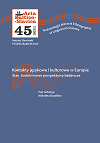Dwujęzyczność polsko-niemiecka w powiecie pilskim, czarnkowsko-trzcianeckim i złotowskim: zarządzanie językiem w trzech pokoleniach na podstawie reprezentatywnych biografii językowych
Polish-German Bilingualism in the Piła, Czarnków-Trzcianka and Złotów Districts: A Study of Language Management in Three Generations Based on Representative Language Biographies
Author(s): Irena PrawdzicSubject(s): Language studies, Recent History (1900 till today), Sociolinguistics, Western Slavic Languages
Published by: Instytut Slawistyki Polskiej Akademii Nauk
Keywords: German-Polish bilingualism; language management; language ideologies;
Summary/Abstract: As part of the project entitled “Language across generations: Contact induced change in morpho-syntax in German-Polish bilingual speech”, members of the research team conducted interviews in Polish and German with 124 bilingual persons in Poland and Germany, including 14 in the Piła, Czarnków-Trzcianka and Złotów districts. Before 1945, Piła and Złotów belonged to the German province of Pomerania, and when the borders were moved both towns became part of Poland. This brought a complete change of the social, geopolitical and language reality of the inhabitants of the region. In the People’s Republic of Poland, efforts were made to eliminate the German language. The situation changed again after the breakthrough of 1989, when the German minority in Poland was officially recognised. On the basis of three language biographies of people born in the 1920s, 1930s and 1950s, which are representative for the Piła-Złotów region, this study presents how the language ideology of linking one country with one language operated over three generations of speakers. It also considers language management at the micro level, taking into account the changes which occurred in 1945 and 1989.
Journal: Acta Baltico Slavica
- Issue Year: 2021
- Issue No: 45
- Page Range: 1-17
- Page Count: 17
- Language: Polish

